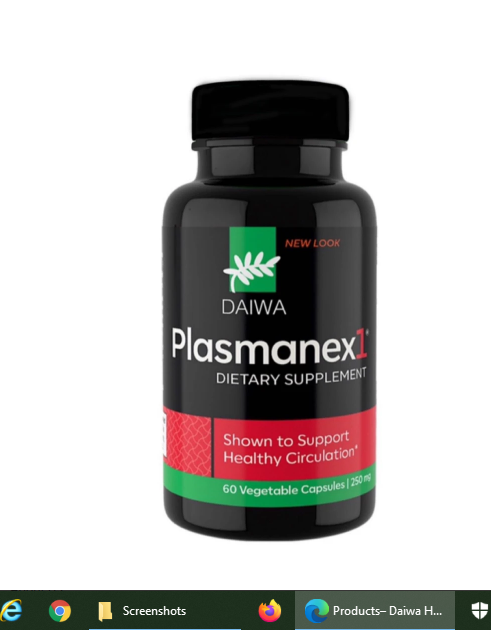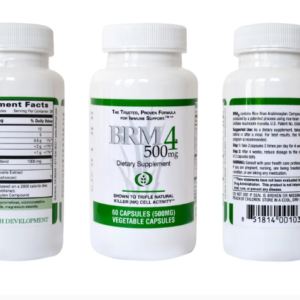Description
한글 내용을 보려면 여기를 클릭하세요
What is Plasmanex1™?
Plasmanex1™ is a dietary supplement shown to promote and support healthy blood circulation. The active ingredient of Plasmanex1 ; is Bacillopeptidase F Proprietary Blend (BFPB). The Blend contains Bacillopeptidase F; a natural soy peptide enzyme extracted by using a patented fermentation production process. Plasmanex11™ is available from Daiwa Health Development.
What is the advantage of a normal blood flow?
Blood circulates throughout the body to transport nutrients and oxygen to all the cells and carries away waste products. Without access to the blood, cells and body tissues are deprived of nutrients and oxygen and tend to die. Maintaining healthy blood circulation and keeping its components circulating efficiently is vital for the nutrient process and oxygenation.
What is the importance of healthy blood circulation?
Healthy circulation in the vessels can help prevent blood clots. Disease states impacted by clots include heart attacks, cerebral infarction (stroke) and pulmonary thromboembolism (blood clots to the lung). Lifestyle factors such as obesity, aging, dehydration, pregnancy, cardiovascular disease and conditions acerbated by cancer, and long distance and frequent travel, are contributing factors to blood clot formation. Plasmanex11™ helps maintain and support optimum blood circulation.
Why does blood clot formation increase with age, overweight, and faulty metabolism?
Our body produces plasmin and related products which maintain enzymes with the ability to break up clots by dissolving fibrin, the material that forms blood clots and eventually entangled red cells and platelets to form the clot. As we age, the body produces less plasmin while fibrinogen and fibrin, levels increase. Therefore, the higher the level of fibrinogen, the greater the possibility of developing blood clots. Furthermore, the older we get the more clotting and the less clot busting ability we have. Increased blood clot formation in millions of Americans each year enhances heart attacks, strokes and limb loss that are a direct or indirect result from unnecessary blood clots, leading to death or permanent disability. Being overweight is an indication of faulty metabolism. Faulty metabolism that results in high triglyceride and low HDL levels is considered to be a major cause of arteriosclerosis.
How does fibrin effect coagulation?
Blood clotting occurs when the blood clotting enzyme, thrombin, breaks down a protein called fibrinogen to create a fibrous material called fibrin. Fibrin creates a web that traps white and red blood cells with platelets and results in clotting. Excessive thrombin or fibrinogen may result in higher levels of fibrin.
What are some of the factors of blood coagulation?
Blood coagulation is a complex process. There are many factors contributing to normal blood coagulation. It is important to keep these factors in balance to avoid disorders of the coagulation system which can lead to increased risk of bleeding and/or excessive clotting. Excessive clotting, called thrombosis, is the formation of blood clots in the circulatory system. Although there are numerous factors that contribute to normal blood coagulation, two processes are very important. They are the thrombin cascade and the plasmin/plasminogen/PAI-1 system.
How do Plasmin, Plasminogen and PAI-1 impact coagulation?
Plasminogen is an inert enzyme in the blood that does not directly effect blood coagulation. It requires a material called t-PA, Tissue Plasmin Activator, to change it to an active form named plasmin that breaks apart blood clots. However, another agent in the blood, PAI-1, Plasminogen Activator Inhibitor, reduces the ability of t-PA to change plasminogen into plasmin. Studies show that PAI-1 promotes blood clot formation and prevents blood clots from dissolving. Elevated PAI-1 levels are associated with increased risk of myocardial infarction and/or heart attack. Therefore to reduce the formation of blood clots, it is desired to reduce the amount of PAI-1 and increase the level of t-PA.
What are the results of blood clots in the circulatory system?
Formation of a clot in a blood vessel, known as thrombus, can break loose and be carried by the blood stream to obstruct another vessel. The clot may block a vessel in the lungs causing a pulmonary embolism or a clot in the brain may induce a stroke. Clot formation may also affect the gastrointestinal tract, kidneys, or legs. Thromboembolism is a main cause of morbidity (incidence or prevalence rate of disease) and mortality (death), especially in adults. Treatment may involve anticoagulants (blood thinners), aspirin, or vasodilators (drugs that relax and widen vessels). Recent findings show that the plasmin/plasminogen system also regulates blood flow in the entire body. What conditions promote the formation of blood clots?
High Cholesterol, particularly Elevated Triglycerides, Low HDL and High LDL
Metabolic Syndrome
Diabetes
Inflammation
Viral, Fungal and Bacterial Infections
Autoimmune Diseases such as Arthritis
Allergies Sleep Apnea
Pulmonary Hypertension
Heart Failure and Left Ventricular Systolic Dysfunction (LVSD)
Varicose Veins and Deep Vein Thrombosis
How does Plasmanex11™ support healthy blood circulation?
Clinical and laboratory studies suggest that Plasmanex1™ may reduce PAI-1, which at elevated levels promotes blood clot formation. High C-reative protein (CRP) levels in patients, an indicator of vascular inflammation or excessive lipid accumulation, is correlated with elevated PAI-1 activity. PAI-1 in turn reduces t-PA, a beneficial enzyme that rapidly breaks down blood clots formed in the blood vessels of the heart, brain and lungs. Plasmanex1™ helps restore blood flow balance by: 1. Decreasing PAI-1, thus reducing the formation of clots 2. Increasing t-PA levels, thus breaking down clots at a faster rate Research demonstrates that Plasmanex1™ helps support healthy blood circulation.
Is Plasmanex1™ safe?
Daiwa Health Development has conducted clinical studies to demonstrate the safety of Plasmanex1™. No clinically adverse events were observed. All tests showed values within normal range and no abnormal changes in hematological or biochemistry tests were registered. Twenty-three healthy adults were given 250mg of Plasmanex1™ daily for 12 weeks in a study conducted at the Department of Legal Medicine, Dokkyo University School of Medicine, Mibu, Japan, and Hanzomon Gastrointestinal Clinic, Tokyo, Japan. No clinical adverse effects were observed. A toxicity study was conducted by the Department of Legal Medicine, Dokkyo University School of Medicine, Mibu, Japan, Seikokai S.S. Clinic, Hachioji, Japan and Department of Strategic Management/IT, Chiba University of Commerce, Ichikawa, Japan. Eight healthy adults were given excess intake of 1,250 mg of Plasmanex1™ daily for 7 days. No clinical adverse effects were observed.
What is the recommended dosage?
Recommended dosage is one or two capsules before bedtime, or one capsule in the morning and one capsule at night. Dosage will vary depending on individual requirements. Consult your healthcare practitioner for proper intake. Following the administration of Plasmanex1™, hemoglobin levels should be checked regularly every 2-3 months and platelet count should be checked every six months by a physician.



